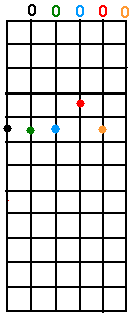|
Need Help Tuning An Acoustic Guitar?
The Best "How To" On Tuning An Acoustic Guitar. Guitar Tuning Doesn't need to be a big chore. On this page, we'll take a look at tuning a guitar. We'll look at ways to do it both with and without an electronic guitar tuner. Here's the "ugly little secret" about tuning a guitar. It's impossible to get a guitar to play totally in tune. There are several factors that cause this.
The good news is that we can usually make the guitar sound in tune. If the guitar is made correctly ( frets in the right place, saddle in right place and compensated correctly,etc...) the guitar can be tuned so that it sounds in tune with it's self. Tuning an acoustic guitar can be done in several ways. Traditionally, it's been done by ear. Something like a tuning fork or a note from another instrument is used as a reference pitch. One string of the guitar is tuned to that pitch. The note from that string is then used to tune the rest of the guitar. It's a lot more common now to use an electronic guitar tuner. Electronic tuners offer something that no other tuning method does. You can see if you're in tune or not. Electronic tuners use either a meter with a needle or LED lights to tell you if you're in tune or not. Most people have spent a lifetime judging things based on appearance. Everything from a shirt's color to whether or not it's time for a haircut. So having a needle tell you if you're nearly in tune or not isn't difficult. In the long run, though, it's also important to be able to tune by ear. Why? Because music is a listening art, not a visual art. Method 2How do you go about tuning an acoustic guitar by ear? Below is a diagram of one of the most common methods used.
You start by tuning your 6th ( largest ) string. You then play the note at the 5th fret of the 6th string. The goal is to have the 5th string "open", or unfretted, match the fretted note on the 6th string. You'll follow this pattern for all of the strings, except the 3rd string. For the 3rd string, you play the 4th fret. Then you tune the 2nd string open to that note. Then it's back to the 5th fret for the next string. To get a better idea about this , you can match the colored dot on the diagram with the same colored 0 at the top of the diagram. HarmonicsThe next most common approach to tuning an acoustic guitar to use harmonics. There are a couple of ways to do this. The first is to use a reference pitch to get your 5th or 6th string in tune. Then play the harmonic at the 5th fret of the string that is tuned. Match this to the harmonic at the 7th fret of the next higher pitched string. After the new string is tuned, tune the next string to it. For the second string, play the harmonic on the 7th fret of the 6th string. Then match the 2nd string open to this harmonic. Another way mixes harmonics and fretted notes.
Before the sound of the harmonics match, they will sound a little "wobbly". When they're in tune the sound smooths out. If none of these options work for you, you can use the online guitar tuner below It will only give you sound. Try matching the sounds of the tuner. Then try using one of the tuning methods above to "double-check" the accuracy of your tuning. Here are some things to consider when tuning an acoustic guitar: These tips on Tuning An Acoustic Guitar should help you play beautiful, in-tune music. If you have any questions, please feel free to contact me.
Return to learn-fingerstyle-guitar.com .
|




